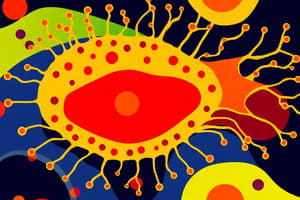Podcast
Questions and Answers
What is the primary function of contractile vacuoles in amoebas?
What is the primary function of contractile vacuoles in amoebas?
- To regulate osmotic pressure (correct)
- To synthesize proteins
- To store food particles
- To produce ATP
Which of the following is a characteristic of amoeba movement?
Which of the following is a characteristic of amoeba movement?
- Using flagella
- Slow and irregular (correct)
- Through muscle contraction
- Fast and directional
What is the method of nutrition in amoebas?
What is the method of nutrition in amoebas?
- Heterotrophic, obtaining energy by consuming other organisms (correct)
- Decomposers, breaking down organic matter
- Symbiotic, relying on other organisms for energy
- Autotrophic, producing energy through photosynthesis
Which type of amoeba is known to cause amoebiasis in humans?
Which type of amoeba is known to cause amoebiasis in humans?
What is the result of asexual reproduction by binary fission in amoebas?
What is the result of asexual reproduction by binary fission in amoebas?
What is the function of pseudopodia in amoebas?
What is the function of pseudopodia in amoebas?
Flashcards are hidden until you start studying
Study Notes
What is an Amoeba?
- A type of protozoan, a single-celled organism
- Belongs to the kingdom Protista
- Characterized by their ability to change shape
Structure
- No fixed shape, but typically irregular or spherical
- Composed of:
- Cell membrane
- Cytoplasm
- Nucleus
- Food vacuoles
- Contractile vacuoles (for osmoregulation)
Movement
- Amoebas move using pseudopodia (false feet)
- Pseudopodia are temporary extensions of the cell membrane
- Movement is slow and irregular
Nutrition
- Heterotrophic, obtaining energy by consuming other organisms
- Feed on bacteria, algae, and small invertebrates
- Ingest food particles through phagocytosis
Reproduction
- Asexual reproduction by binary fission
- Division occurs in multiple directions, resulting in two or more daughter cells
- Can also reproduce sexually through conjugation
Types of Amoebas
- Amoeba proteus: a common freshwater amoeba
- Amoeba dubia: a species of amoeba often used in scientific research
- Entamoeba histolytica: a parasitic amoeba that causes amoebiasis in humans
What is an Amoeba?
- A single-celled organism, belonging to the kingdom Protista
- Characterized by ability to change shape due to lack of cell wall
Structure
- No fixed shape, irregular or spherical in shape
- Composed of cell membrane, cytoplasm, nucleus, food vacuoles, and contractile vacuoles for osmoregulation
- Cell membrane is flexible, allowing for shape changes
Movement
- Move using pseudopodia, temporary extensions of cell membrane
- Pseudopodia are formed by cytoplasm flowing into a specific area
- Movement is slow and irregular, helping in capturing food particles
Nutrition
- Heterotrophic, obtaining energy by consuming other organisms
- Feed on bacteria, algae, and small invertebrates
- Use phagocytosis to ingest food particles, engulfing them with pseudopodia
Reproduction
- Asexual reproduction through binary fission
- Division occurs in multiple directions, resulting in two or more daughter cells
- Can also reproduce sexually through conjugation, involving exchange of genetic material
Types of Amoebas
- Amoeba proteus: common freshwater amoeba
- Amoeba dubia: species often used in scientific research
- Entamoeba histolytica: parasitic amoeba causing amoebiasis in humans
Studying That Suits You
Use AI to generate personalized quizzes and flashcards to suit your learning preferences.




